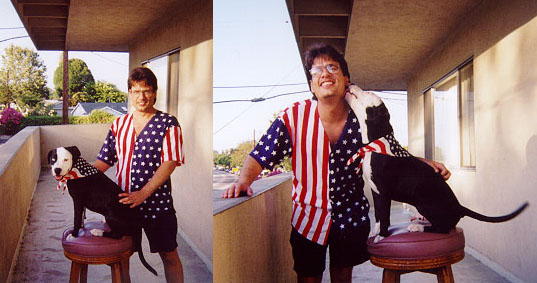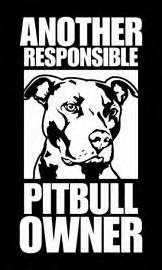NOTE: the following information is owned and copyrighted by the owner of Pitbull411.com and cannot be redistributed or posted elsewhere without permission.
The American Pit Bull Terrier is a wonderful dog, well-known for its intelligence, strength, and loyalty. In recent years, the breed has been unfairly villanized as overly aggressive and dangerous. While the Pit Bull does indeed possess a feisty and spirited character, the history of the breed reveals a much more complex tapestry of temperament and personality.
Like many modern breeds, it is impossible to be completely sure of the details of the American Pit Bull Terrier's long history. However, many Pit Bull enthusiasts believe the origins of the breed can be traced back to antiquity and the Molossian family of dogs. The Molossian family of dogs bears the name of the people with whom they were most often associated - the Molossi tribe, a group of people who lived in ancient Greece and favored the use of robust, muscular dogs in warfare. Officially termed canus molossi (dogs of the Molossi), these animals were reknowned for their fierceness, and for their innate ability to intimidate the enemies of the tribe.
During this same time period, it is also believed that the Molossian dogs were used for other purposes. In fact, early Phoenician traders may even have used the Molossians as a bargaining item in their commercial transactions.
The Molossians gave rise to another family of dogs known as the Mastiffs. The early Britons employed a variation of the Mastiffs as pugnaces - fighting dogs that could be used in either a guardianship or warfare capacity. When the Roman emperor Claudius defeated the Briton Chief Caractacus in 50 AD, the powerful pugnaces piqued his interest. He quickly seized on the opportunity and began exporting select quantities of the dogs back home to satiate his countrymen's appetite for entertainment in the arenas and coliseums of Rome.
Once in Rome, the British dogs were crossbred with their Roman counterparts. From the years 50 AD to 410 AD, the breed was widely disseminated throughout the Roman Empire for use as fighting dogs. Along the way they mixed with other indigenous breeds throughout Europe, creating a genetic melting pot for the bulldogs that are thought to have been the immediate antecedents of the American Pit Bull Terrier.
Sadly, the Romans would not be the last to use Pit Bulls in cruel and grisly blood sports. When the Normans invaded England in 1066, they introduced a new sport called baiting. Interestingly enough, baiting originated with butchers who kept dogs (called Bullenbeissers) to handle unruly bulls as they were herded to the market for slaughter. When a bull stepped out of line or exhibited uncontrollable behavior, the dogs would clamp down on its nose and simply hang on until the handler could regain control of the wayward animal.
Like most dog owners, the butchers were proud of their canine companions and their stubborn tenacity in dealing with the much larger, and potentially dangerous bulls. Consequently, pubic displays were arranged to showcase the dogs' abilities and, quite frankly, to appease the multitudes that attended baiting events for their entertainment value.
By the 16th century, nearly every town in England had its own baiting ring. The popularity of baiting events was unparalleled at the time, as was their ability to draw spectators from every level of society. Their popularity was further enhanced by the misguided perception that prolonged torture ensured the tenderness of the meat.
In baiting events, no more than one or two dogs were unleashed on the bull. They were trained to unrelentingly harass the bulls until they collapsed from fatigue, their injuries, or both. These episodes lasted for prolonged periods, sometimes as long as three or four hours. Eventually, the public's grew bored with bulls and introduced a creative flair to the sport, baiting dogs with bears, boars, horses, and even monkeys!
In 1406, Edmond de Langley - the Duke of York - produced a short treatise for Henry IV entitled, "The Master of the Game and of Hawks." In it, he described a descendent of the ancient Mastiffs that he called the "Alaunt", the most commonly used baiting dog of the era. A 1585 painting of the Alaunts hunting wild boar portrayed lean, muscular animals with profound similarities to the dogs we know as Pit Bulls.
Baiting was made illegal by the British parliament in 1835. However, this legislation did little to satiate the public's desire to watch the spectacle of dogs in fighting sports. As a result, their attention turned to a variety of other pursuits such as ratting - a practice in which a dog was thrown in a pit with a varying number of rats. The dogs raced against the clock and each other to determine which one could kill the most rats in the shortest period of time. The "pit" in Pit Bulls comes from the fact that ratting occurred in a pit that kept the rats from escaping.
Ultimately the public's fickle gaze fell on the sport of dog fighting, primarily because it could be more easily hidden from the prying eyes of the law than baiting and other fighting sports. Since dog fighting required smaller and more agile animals than the ones that were used in baiting, fighting bulldogs were bred with terriers who were known for their feistiness and indefatigable focus. The result was the bull-and-terrier, more commonly known as the first Pit Bull terrier - a muscular, canine gladiator bred specifically for combat with other dogs.
As you can imagine, dog fighting was an extremely cruel and sadistic pursuit. The canine combatants were put through a rigorous training process depriving them of normal contact with humans and instilling in them an intense desire to spill the blood of their opponents. It was not unusual for these dogs to be fed a diet of blood and raw meat, and to be kept in complete darkness apart from the few hours a day they spent training with their handlers. To further enhance the dogs' eagerness for the kill, handlers forced them to run on a stationary treadmill with a weaker animal in front of them, but just out of reach. At the end of the exercise, the dogs were allowed to kill the animal as their reward.
During the course of a dog fight, the dogs were expected to fearlessly hurl themselves at their opponents without flinching or hesitation. If a dog turned away, it was viewed as a weakness and could be grounds for forfeit. Even if the hesitant animal was lucky enough to survive the encounter, he was still not out of the woods. Many handlers killed their own dogs because they believed a dog that hesitated even once could no longer be relied on to fight with the verve and tenacity the sport required.
When English immigrants came to America, their dogs came with them. Not surprisingly, dog fighting was common in America throughout the 19th century. However, as the immigrants traveled west, the Pit Bull took on a broader and more humane function. On the frontier, Pit Bulls assumed the role of an all-purpose dog. In addition to herding cattle and sheep they served as faithful guardians, protecting families and livestock from the ever-present threat of thieves and wild animals.
Despite their gallant history, Pit Bulls faced an uphill battle in gaining official recognition. The American Kennel Club was formed in 1884 for the sole purpose of promoting the interests of purebred dogs and their owners. To accomplish this, they sponsored events designed to test various breeds in the areas of performance and conformation.
Conformation events judge the dogs according to the breed standard - a pre-established set of guidelines that describe the most-highly valued physical characteristics of each breed. Performance events, on the other hand, test the dogs according to the function for which they were bred. Some of the more common performance categories include the working, sporting, and herding categories.
The performance events created an immediate problem for the Pit Bull since the function for which they were bred - fighting - was illegal. Furthermore, the AKC understandably refused to remotely endorse anything related to dog fighting.
In response to the AKC's unwillingness to include Pit Bulls as a bonafide breed, in 1898 an alternative group was formed - the UKC (United Kennel Club). The purpose of the UKC was to certify breeds that were not eligible for certification by the AKC. Not surprisingly, the UKC's charter member was the American Pit Bull Terrier.
Ultimately the AKC did recognize the Pit Bull in 1936, albeit under the designation of the Staffordshire Terrier, named after the region of England where the crossbreeding of bulldogs and terriers is thought to have begun. Today, the AKC continues to include the American Staffordshire Terrier in its registry, although ironically this has now developed into a breed that is distinct from its American Pit Bull Terrier cousin.
Over the years, the American Pit Bull Terrier has been a beloved symbol of Americana. In World War I, a Pit Bull named Stubby captured the heart of the nation. Stubby was the unofficial mascot of the 102nd Infantry Division and was credited with saving the lives of several of his human comrades. For his valiant service, Stubby won several medals and was even awarded the rank of sergeant! He came home from the war to a hero's welcome and went on to become the mascot for Georgetown University.
Over the years, many famous Americans have owned Pit Bulls. Mark Twain, Theodore Roosevelt, Laura Ingalls Wilder, Thomas Edison, Woodrow Wilson, General George Patton, John Steinbeck, Helen Keller, Fred Astaire, Jamie Foxx, Rachael Ray, Jon Stewart, Ken Howard, Jessica Biel, Jessica Alba, Kevin Federline, Pink and many more have all been proud to own dogs of this breed. The actor Ken Howard (the father on the TV show Crossing Jordan) even credits his Pit Bull with saving his life. President Roosevelt had 13 Pit Bulls at the White House during his tenure.
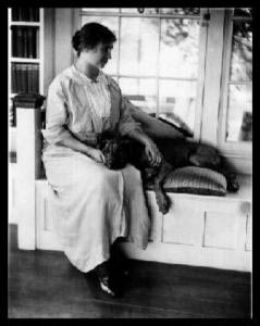
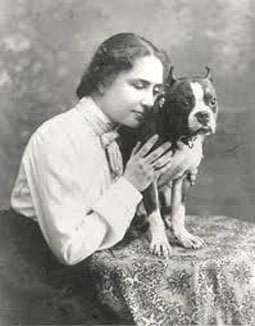
Left: Helen Keller and her Pit Bull Sir Thomas

Helen Keller never thought of her Pit Bull as a service dog... she
always referred to him as her closest companion.
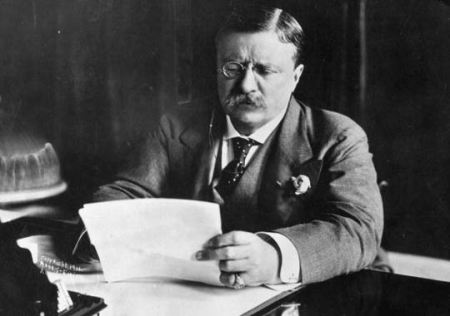
Theodore Roosevelt had Pit Bulls living with him at the White House.
Commonly known at the time as "Nanny Dogs" because of their
foundness for children, it is said that "Teddy" was a big kid himself
when it came to the relationships he had with his Pit Bulls.
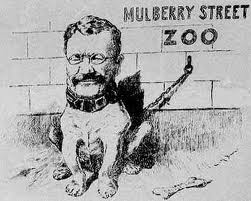
President Rooselvelt was often potraid as 1/2 human 1/2 Pit Bull...
a likeness he embrased.
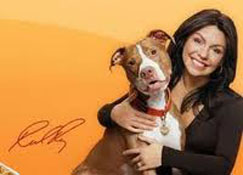
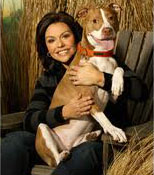
Rachael Ray has made her cause for Pit Bulls more famous
than her own cooking show on TV.
Pit bulls have crept in the hearts of Americans through a variety of ways. For years, RCA's Victrola Brand looked to a Pit Bull as its corporate logo for the Victrola dog. Similarly, Buster Brown Shoes used a Pit Bull as the cornerstone of their marketing campaign.
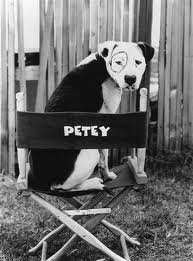
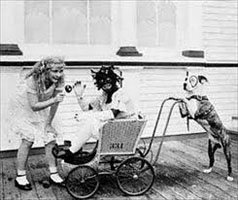

But, perhaps the most famous Pit Bull was Petey, the adorable ring-eyed cutey featured on the TV show Little Rascals. In no time at all, Petey secured a place alongside Alfalfa, Spanky, and the other rascals as a national treasure. A little known fact about Petey is that his telltale ring actually changed form one eye to the next between seasons of the TV show. Although no one knows for sure why this happened, it is rumored that the original Petey was poisoned and was replaced by a look-a-like, or at least a look-a-like with markings that necessitated the eye change.
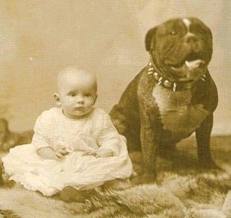
Nanny Dogs as they were known in the late 1800s to early 1900s
because of their national exceptance as caretakers to watch over children.
Today, the American Pit Bull Terrier is a beloved animal that is used in a variety of helping functions in society including police dogs, search dogs, therapy dogs, and farm dogs. Even so, negative publicity has led many cities to condemn them as a community problem. This perception has been supported by the prevalence of illegal dog fighting in cities and small towns across America. In recent years, gangs have taken a fancy to dog fighting and elevated the ownership of trained fighting dogs as a status symbol.
Pit bulls have born the brunt of the backlash because of their popularity with dog fighters. This has caused the public to demand legislative action against Pit Bulls. Yielding to the pressure of their constituents, public officials have banned Pit Bulls in many civil jurisdictions and others are following suit including insurance companies who reserve the right to cancel a homeowner's policy if it is learned that a Pit Bull resides on the premises.
The negative treatment of Pit Bulls in our society is unfortunate to say the least. Pit bulls and people can live harmoniously if given the chance. Training is an important consideration in Pit Bull ownership. The history of the breed demonstrates that unless he is properly trained and socialized at a young age, this strong-minded dog will quickly attempt to dominate the household. However, with the proper training the American Pit Bull Terrier can be a remarkably loyal and valued member of the family.
Sources Consulted:
1. Dr. Dieter Fleig, The History of Fighting Dogs, trans. by William Charlton, (Neptune, NJ: TFH Publications, 1996)
2. D. Caroline Coile, Pit Bulls for Dummies, (Indianapolis, Indiana: Wiley Publishing Inc., 2001)
3. American Pit Bull Registry (http://www.pitbullregistry.com/Pit%20Bull%20History.htm)
4. BulldogBreeds.com (http://www.bulldogbreeds.com/americanpitbullterrier.html)
5. The Bulldog Information Library - Molossars (http://www.bulldoginformation.com/ molossers-mastiff-type-dogs.html)
6. Dog Owner's Guide - American Pit Bull Terrier (http://www.canismajor.com/ dog/amerpit.html)
7. The Real Pit Bull (http://www.realpitbull.com/history.html)
Author: This article was researched and written by Timothy Morral for Pitbull 411. Copyright Notice: This content is owned and copyrighted by Pitbull411.com. This article cannot be redistributed or posted elsewhere without permission.

